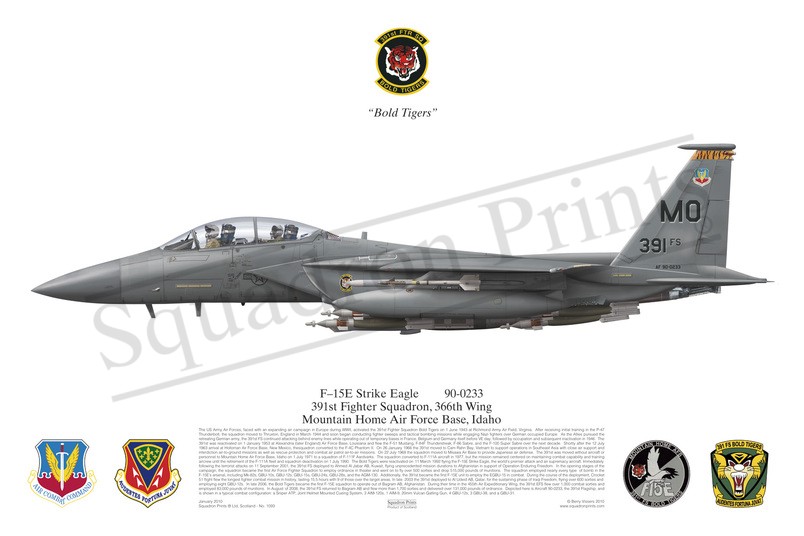#1093 F-15E Strike Eagle

Purchased products will not feature the Squadron Prints watermark
Description
Squadron Prints Lithograph No. 1093 - F-15E Strike Eagle, 90-0233, 391st Fighter Squadron, 366th Wing, Mountain Home Air Force base, Idaho.
The US Army Air Forces, faced with an expanding air campaign in Europe during WWII, activated the 391st Fighter Squadron Bold Tigers on 1 June 1943 at Richmond Army Air Field, Virginia. After receiving initial training in the P-47 Thunderbolt, the squadron moved to Thruxton, England in March 1944 and soon began conducting fighter sweeps and tactical bombing missions while engaging Nazi fighters over German occupied Europe. As the Allies pursued the retreating German army, the 391st FS continued attacking behind enemy lines while operating out of temporary bases in France, Belgium and Germany itself before VE day, followed by occupation and subsequent inactivation in 1946. The 391st was reactivated on 1 January 1953 at Alexandria (later England) Air Force Base, Louisiana and flew the F-51 Mustang, F-84F Thunderstreak, F-86 Sabre, and the F-100 Super Sabre over the next decade. Shortly after the 12 July 1963 arrival at Holloman Air Force Base, New Mexico, thesquadron converted to the F-4C Phantom II. On 26 January 1966 the 391st moved to Cam Rahn Bay, Vietnam to support operations in Southeast Asia with close air support and interdiction air-to-ground missions as well as rescue protection and combat air patrol air-to-air missions. On 22 July 1968 the squadron moved to Misawa Air Base to provide Japanese air defense. The 391st was moved without aircraft or personnel to Mountain Home Air Force Base, Idaho on 1 July 1971 to a squadron of F-111F Aardvarks. The squadron converted to F-111A aircraft in 1977, but the mission remained centered on maintaining combat capability and training aircrew until the retirement of the F-111A fleet and squadron deactivation on 1 July 1990. The Bold Tigers were reactivated on 11 March 1992 flying the F-15E Strike Eagle, the world’s premier attack and air supremacy aircraft. Immediately following the terrorist attacks on 11 September 2001, the 391st FS deployed to Ahmed Al Jabar AB, Kuwait, flying unprecedented mission durations to Afghanistan in support of Operation Enduring Freedom. In the opening stages of the campaign, the squadron became the first Air Force Fighter Squadron to employ ordnance in theater and went on to fly over 500 sorties and drop 515,000 pounds of munitions. The squadron employed nearly every type of bomb in the F-15E’s arsenal, including Mk-82s, GBU-10s, GBU-12s, GBU-15s, GBU-24s, GBU-28s, and the AGM-130. Additionally, the 391st became the first F-15E unit to employ the EGBU-15 in combat. During the course of the deployment, Crocket 51 flight flew the longest fighter combat mission in history, lasting 15.5 hours with 9 of those over the target areas. In late 2003 the 391st deployed to Al Udeid AB, Qatar, for the sustaining phase of Iraqi Freedom, flying over 600 sorties and employing eight GBU-12s. In late 2006, the Bold Tigers became the first F-15E squadron to operate out of Bagram AB, Afghanistan. During their time in the 455th Air Expeditionary Wing, the 391st EFS flew over 1,000 combat sorties and employed 83,000 pounds of munitions. In August of 2008, the 391st FS returned to Bagram AB and flew more than 1,700 sorties and delivered over 131,000 pounds of ordnance. Depicted here is Aircraft 90-0233, the 391st Flagship, and is shown in a typical combat configuration: a Sniper ATP, Joint Helmet Mounted Cueing System, 3 AIM-120s, 1 AIM-9, 20mm Vulcan Gatling Gun, 4 GBU-12s, 3 GBU-38, and a GBU-31.
You may also like
-
Diamond Jubilee Typhoon Flypast 2012 Signed By Lorraine Kelly
11 Sqn; 29 Sqn; 17 Sqn; Typhoon Force ; 3 Sqn; 6 SquadronRAF Lossiemouth; RAF Coningsby
